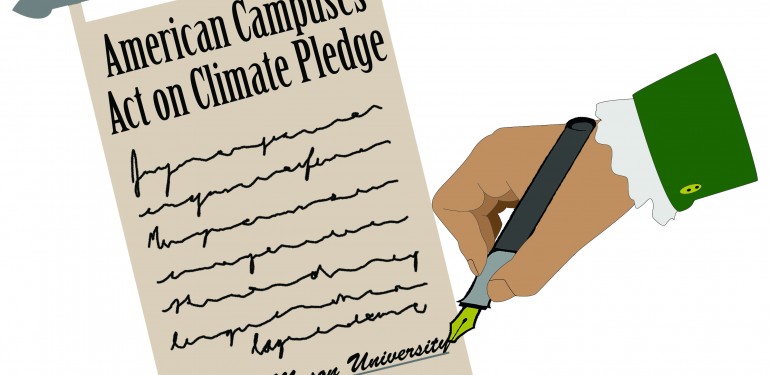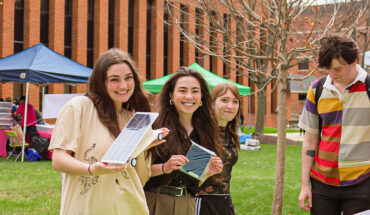This story was originally published in the Feb. 22 issue of Fourth Estate.
(Photo credit: Megan Zendek/Fourth Estate)
This past December, Mason joined a list of over 200 colleges and universities in signing the American Campus Act on Climate Pledge.
By signing this pledge, initiated by the White House, each of these universities committed to lowering carbon emissions and increasing sustainable practices.
“As institutions of higher education, we applaud the progress already made to promote clean energy and climate action as we seek a comprehensive, ambitious agreement at the upcoming United Nations Climate Negotiations in Paris,” the pledge stated, according to a White House press release.
The pledge says that participating institutions recognize the urgent need to act now to avoid irreversible costs to the global community’s economic prosperity and public health. It added that signatories are optimistic that world leaders will reach an agreement to secure a transition to a low-carbon future.
“Today our school pledges to accelerate the transition to low-carbon energy while enhancing sustainable and resilient practices across our campus,” the pledge read.
Graduate student Giulia Manno, the sustainability outreach coordinator for the Office of Sustainability, said the pledge was signed in support of President Obama before he attended the Paris climate talks last November and December.
Manno said that in signing the pledge, these colleges and universities proved to the international community that Obama had both support and invested commitment in impacting climate change both at home and abroad.
The pledge came to Mason’s attention when an individual with the White House approached Dr. Edward Maibach, a communication professor and the director for the Center for Climate Change Communication, and further reached out to Jim Kinter, the director of the Center for Ocean, Land and Atmosphere studies. According to Danielle Wyman-Castellano, the outreach and community engagement manager for the Office of Sustainability, Maibach, Kinter and their colleague Jagadish Shukla, the director of the Climate Dynamics Program, then brought the information to President Angél Cabrera who decided to sign the pledge.
Cabrera and his team then took the next step by deciding which goals Mason would submit to the White House as part of the pledge.
Building off of previous objectives, the goals will first aim to collaborate with local municipalities to provide more sustainable public transportation opportunities through shuttle buses, bike-share systems, bike infrastructure and shared vehicle options. The second part states that Mason will aim to achieve climate neutrality by 2050 and, as part of that endeavor, meet a milestone in 2020 of a 50 percent reduction in energy intensity from its 2006 baseline. The university also hopes to achieve a 50 percent recycling rate increase by 2018. Wyman-Castellano added that Mason is currently on track to meet its 2018 goal.
“For multiple reasons, this is … really important. If we are to stand any chance in moving forward with climate neutrality goals, it is imperative that we have the support from all levels, from students, staff and faculty members of the university, to be able to advance these goals,” Wyman-Castellano said.
Wyman-Castellano added that some of the biggest emitters of carbon at Mason are buildings and forms of transportation. She and Manno suggested that one way students can have an impact on the reduction of carbon is by taking advantage of some of the carpooling programs Mason offers on campus, such as the Student Carpool Program and Zimride.
“As with anything on campus, [and] we have seen this time and again, it is truly without a doubt, it is the students that push things forward,” Wyman-Castellano said. “If the students get on board with something and they really come out in strong numbers in support for something, we’ve seen the entire university change. It’s really incredible what students are able to do.”
Maibach said via email that students and universities should continue to do what they do best.
“Universities can do what they do best — innovate, educate, and engage members of their communities. Most importantly, we need universities to focus on developing the solutions we need — most importantly: cheap, reliable, clean energy, and better ways to store, transport and manage it,” the email read.
Kinter echoed Maibach and believes that Mason being such a large research institution offers a great opportunity. He said that because Mason has the opportunity to research and learn about the effects of climate change, it has the chance to find solutions to these problems as well.
Wyman-Castellano said that from her perspective, students are very concerned about environmental issues.
“A lot of the students that we talk with and interact with on social media, they are extremely concerned, alarmed actually, about where things are headed [and] what decisions are global leaders making with regard to climate change policy. And [they are] vocal about it too,” Wyman-Castellano said.
Wyman-Castellano said that the conversations happening among college students right now are very robust and productive and they are actually making change happen. She added that she would love to see a broader conversation that would include students from all groups and demographics. However, Wyman-Castellano noted that in her experiences, older generations seem to be remorseful about issues that younger generations are facing.
“Some of my family members are very supportive and they think that what we’re doing is really important and they can see, in hindsight, some of the damage that was caused,” Wyman-Castellano said. “And they’re like ‘to a certain degree, we’ve really screwed things up, but it’s so great and we’re so inspired and we stand behind you for doing what you’re going to do and then pushing forward and fixing our mistakes.’”
Wyman-Castellano said that while this White House pledge is the first global commitment Mason has made to sustainability, it is not the first time the university decided to take action on this topic.
In 2007 and 2008, the American Colleges and University Presidents Climate Commitment was signed by former Mason president, Alan Merten. Wyman-Castellano said that was the first time that Mason really publicly committed to reaching climate neutrality by 2050 and this commitment was the reason the Office of Sustainability was formed.
In 2010, Mason also adopted a Climate Action Plan. This plan involved a slightly less ambitious goal compared to the White house pledge goal, with a 20 percent reduction of emissions by 2020 and an 80 percent emission reduction by 2050.
“We have the Climate Action Plan; however it is six years old. It’s outdated. The next step is really to update it and figure out what are the [next steps]. From that document, we’ve hit a lot of the low-hanging fruit already, so we need to revisit the document, update it and sort of craft our next path forward,” Wyman-Castellano said.
The follow-up to the Climate Action Plan would eventually be the White House pledge with it’s somewhat more ambitious emission reduction goals.
“Thank goodness Mason got onto this [list]. It’s really, really important and really significant because we’re the thought leaders,” Wyman-Castellano said. “This is the direction that society is going in.”




